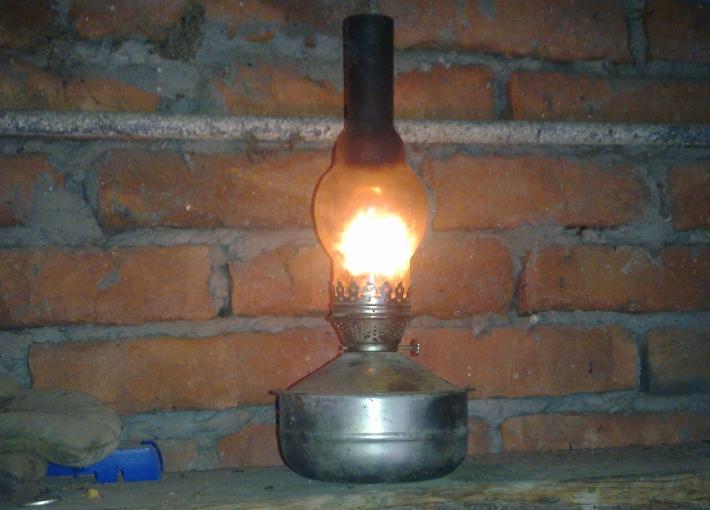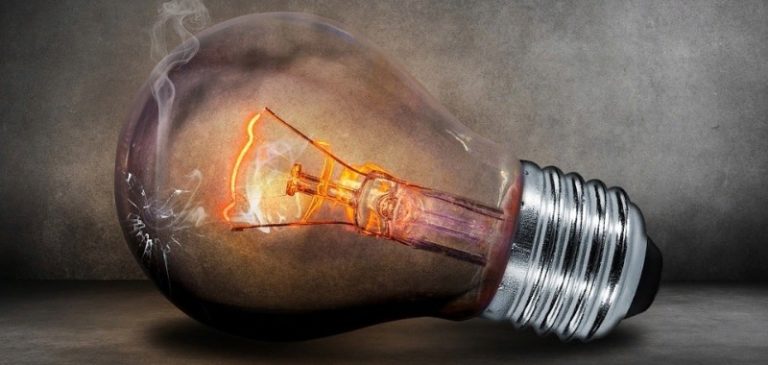History of electric lighting
The history of electric lighting goes back to the century before last. Scientists in the early 18th century discovered that by heating various materials with electricity can produce bright light. But the development of technology was at a low level, so the development of a durable and safe light bulb took almost a century. During this time, many experiments have been conducted. These days, work is also being done to improve the lamps, not so long ago there were new variants that are becoming more and more popular.
Light sources before the advent of electricity
Since the earliest times people tried to provide lighting in the dark. And, at first it also served as protection from predators. There are a few distinct phases in the development of our sources of light:
- Campfire. The first and simplest variant, which was kindled in a cave or a makeshift shelter and was constantly maintained because people did not know how to make fire by themselves at that time.
- Firelighters. Over time, people noticed that some resinous species of wood burn much brighter and longer than others. They began to be used for lighting by splitting them into small splinters and lighting them as they burned, which saved material and provided light for a long time.
- The first lamps were primitive in design. A small wick was dipped into a container of oil, natural resin or animal fat and burned for a long time. Over time, refined petroleum products were used, which further increased the efficiency. Flares and other variants impregnated with combustibles appeared.
- Wax and paraffin made it possible to make candles that helped illuminate a room for a long time. More often than not, wax was collected and used in the re-making of candles.
- Oil and then oil lamps were the next stage of development. The design was a wick, which was soaked in a container and through a special system was extracted little by little for even burning. To protect the flame and make the light more even, a protective glass was used on top.Kerosene lamps were among the most efficient and safest.
- Gas lamps were widely used for street lighting in Great Britain and some other countries. Due to the convenience of gas delivery and ease of connection, it was possible to obtain a sufficiently powerful light source, which is easy to light and extinguish.
By the way! All sources of lightthat preceded the electric ones were not safe. So they caused fires and sometimes even burnt out large parts of cities.
Stages of development of lighting
After electricity was invented, it became clear to many scientists that increasing the temperature of the heated element was necessary to improve lighting efficiency. The easiest way to do this was with electricity. Current makes it possible to heat some materials to such a temperature that they begin to glow, and for all such options are characterized by common features:
- The brightness of the glow is directly proportional to the degree of heating.
- The radiation has a continuous spectrum.
- The maximum saturation of lighting depends only on the temperature of the body being heated.
The Russian scientist was the first to propose the use of electric arcs for illumination В. Petrov in 1802.. In the same year the British researcher Г. Davy proposed his own version of a light source that worked by feeding electricity to strips of platinum.
Work continued for decades, but all variants did not gain much traction because of the complexity of the design and the high price of platinum.
Carbon filament
The first scientist to receive a patent for a lamp with an inexpensive carbon filament was the American Д. Starr in 1844.. He proposed a design that made it possible to replace the carbon element because it only lasted a couple of hours. Over the decades, many researchers improved the design, until in in 1879, Thomas Edison patented the lampwhich everyone is familiar with. At the same time, many believe that in his research he applied the work of the Russian scientist Lodygin ..
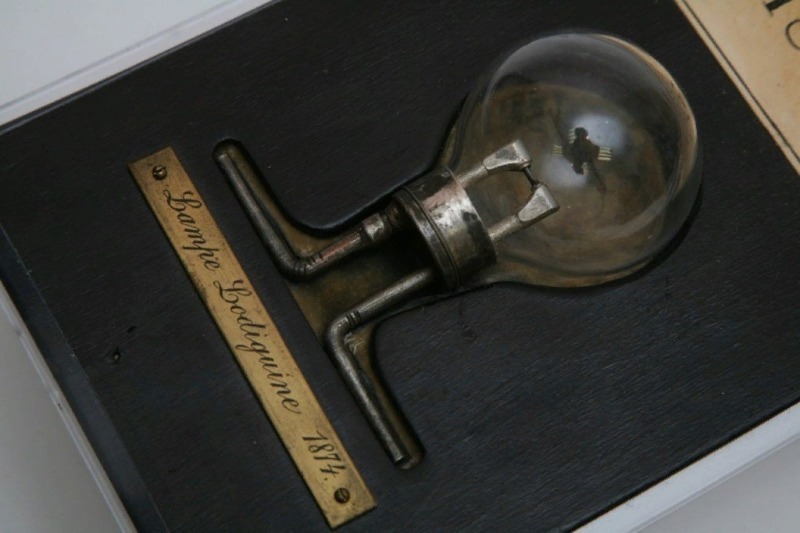
The first versions worked for several hours. Then models with a life time of 40 hours appeared, which was a fantastic figure at that time. Edison and a team of researchers continued to improve the bulb, which allowed for a resource of 1200 hours.
An even greater success was achieved by the French scientist Chailléwho, at the end of the 19th century, developed an even more durable and brighter carbon filament lamp. The company, opened in the U.S., flourished for half a decade. But Chaillé didn't have time to readjust in time and the new generation of lamps with tungsten supplanted the carbon variety from the market.
By the way! At the Livermore Fire Department in California, USA, a "perpetual" carbon filament light bulb burns for 113 years.
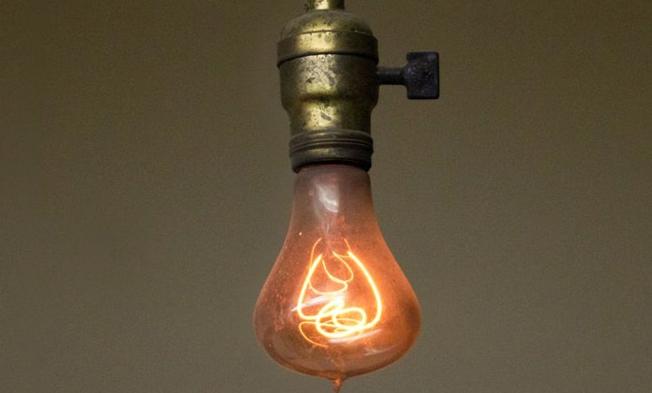
Incandescent Lamp
In the late 19th century, the Russian researcher Lodygin began to experiment with the use of refractory metals - molybdenum and tungsten. It was he who decided to twist the filament into a spiral, as this increased the resistance of the material, increased the brightness of the glow and prolonged its life. Eventually, he sold the patent for the tungsten filament to Thomas Edison's General Electric, which perfected the technology.
An employee of an American company. Irving Langmuir suggested filling the bulb with inert gas to prolong the life of the tungsten filament and improve its luminescence performance. This ensured a long service life and allowed the production of inexpensive and high-quality products that have survived almost unchanged to the present day.
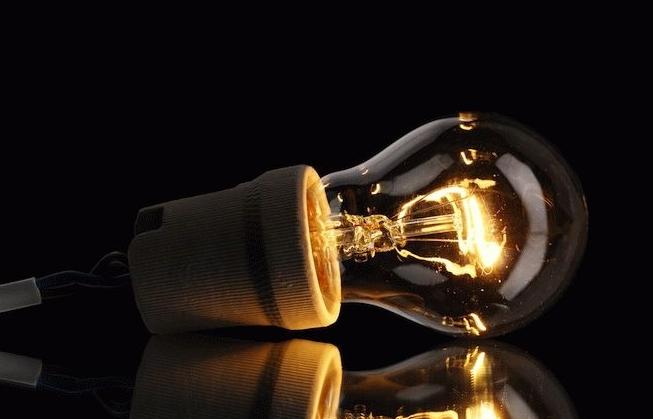
Halogen lamps - An improved version that uses noble metal pairs. They increase the brightness of the luminescence and extend the life of the lamp considerably.
Fluorescent lamps
The development of electric lighting has led researchers to look for other options that would provide good brightness with increased efficiency. After all, in incandescent bulbs Most of the energy goes to the heating of the coil and is released as heat.
The first to propose the use of the design in its modern form American scientist Э. Germer in 1926.. The patent was later acquired by General Electric, which refined some elements of the device and in 1938 launched this type of lamps in commercial production.
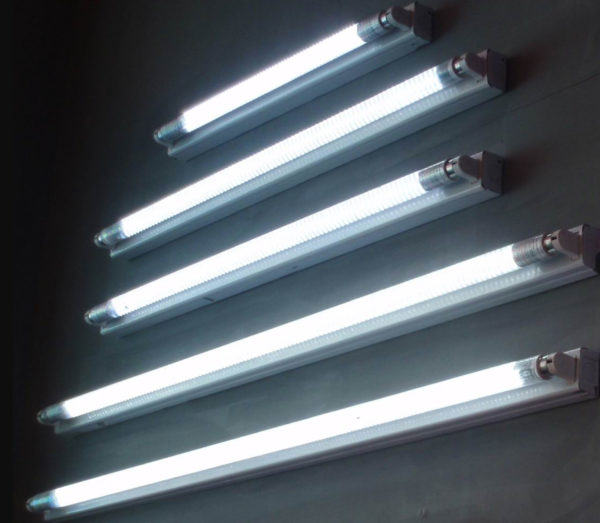
Working principle The glow is different from the standard versions, because it is produced by an arc discharge between two electrodes located at different ends of the bulb. The inner space is filled with a mixture of inert gas and mercury vapor, which produces ultraviolet radiation. To convert it into visible light, the walls of the bulb inside are coated with phosphor. By changing the composition of the coating, different characteristics of light can be achieved.
Due to this principle of operation the same intensity of light is provided as in the incandescent lamp, but the energy costs are reduced by a factor of 5. At the same time the light is diffused, which provides greater comfort for vision and better light distribution in the room. With proper installation and operation, the service life is several times longer than that of classic products.
But there are disadvantages to this option, most importantly, the presence of mercury vapor insidewhich creates a damage hazard and requires separate disposal of lamps. They do not tolerate constant switching on and off and are best used in places where lighting is in constant operation.
Compact fluorescent lamps with standard tubes have all the advantages of the standard tube models. They can be used as an alternative to incandescent lamps without any system modification.
LED light sources
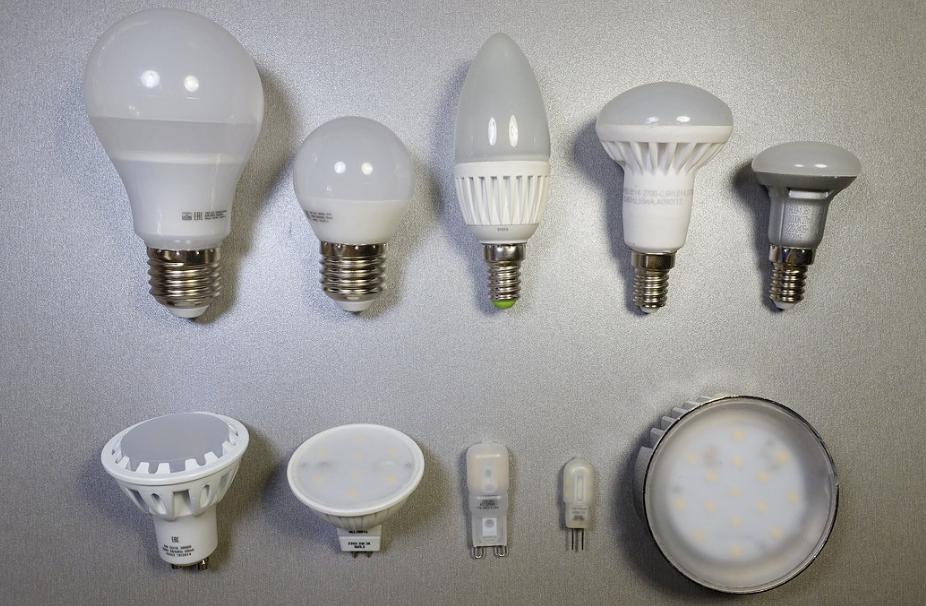
This option appeared relatively recently, but at a rate overtaking the other varieties and is spreading more and more every year. The source of light are LEDs white, when ultra-bright versions were developed, this trend has become promising for both indoor and street lighting.
The solution has many advantages, which provide its popularity:
- Lowest power consumption. Compared to an incandescent bulb, the difference is almost 90%. By installing LED lighting, you can save electricity.
- The efficiency is much higher, since energy is not wasted on heating the coil or arc discharge.
- The lifespan under normal operating conditions can exceed 50,000 hours. This is much longer than any other kind.
- LEDs can produce light with different color temperatures, allowing you to find the right solution for any purpose. At the same time there is almost no flicker, which reduces the strain on the eyesight.
- You can buy both fixtures and bulbs for a standard socket.
There are certain disadvantages of LEDs. First of all, it is demanding on the quality of the heat sink. If it does not cope with the removal of excess heat, the work of the LEDs is broken, and the resource is significantly reduced. On sale there are many low-quality products with diodes that do not provide a normal quality of light.
The video details the history and evolution of lighting.
Electric lighting has gone through several stages in its development. And it should be noted that all variants of the light bulbs except for the variant with a carbon filament are still used today. And despite the development of technology and the emergence of LED light sources the leading role is still incandescent lamps, the volume of their annual production exceeds all others combined.
